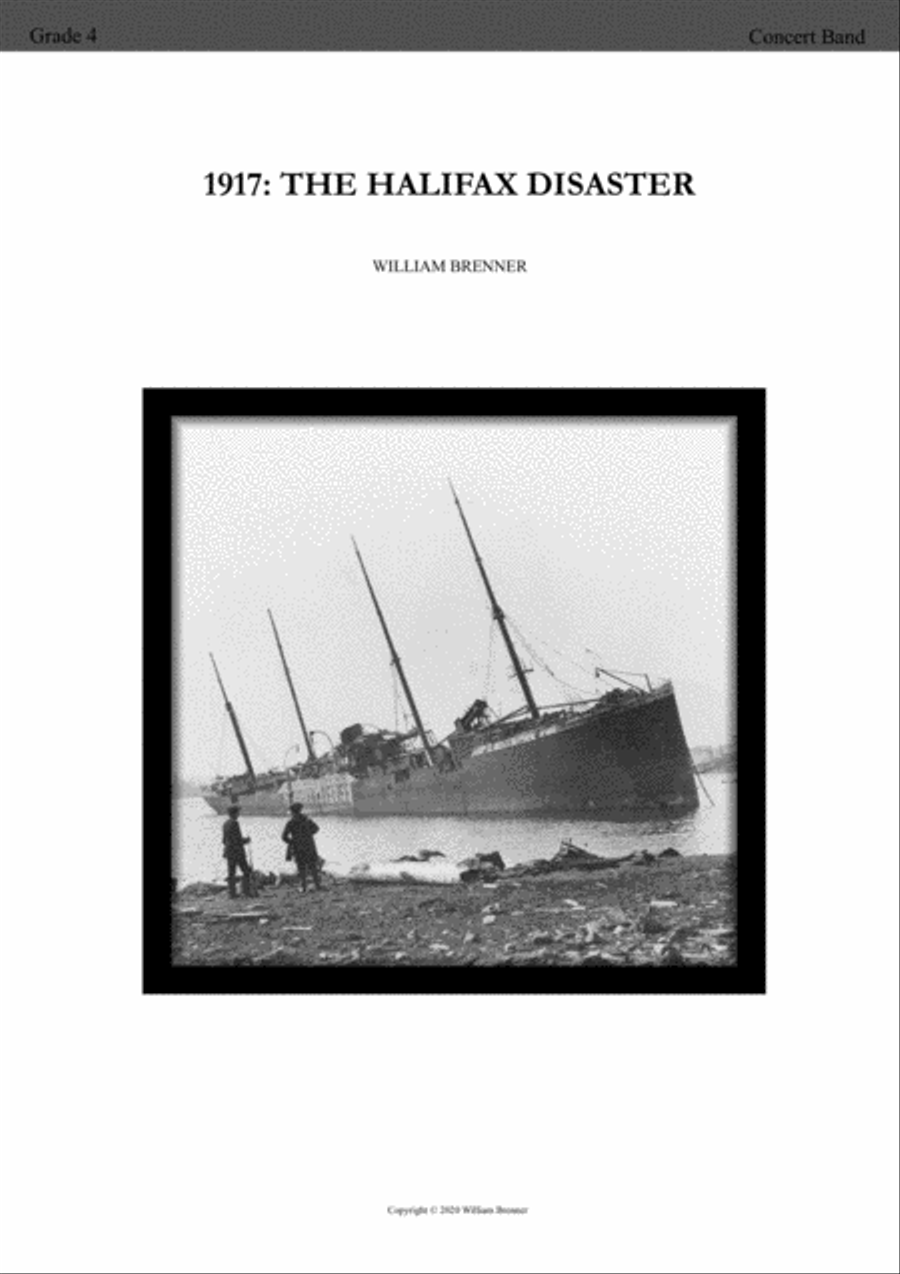Concert Band - Level 4 - Digital Download SKU: A0.1008264 Composed by William Brenner. Contemporary. Score and parts. 80 pages. William Brenner #5370501. Published by William Brenner (A0.1008264). Halifax was devastated on 6 December 1917 when two ships collided in the city's harbour, one of them a munitions ship loaded with explosives bound for the battlefields of the First World War. What followed was one of the largest human-made explosions prior to the detonation of the first atomic bombs in 1945.(...)In early December, one of the merchant ships in port was the large, Norwegian vessel Imo, en route from Halifax to New York to pick up relief supplies (...) Another was the French munitions ship Mont-Blanc - filled with tons of benzol, the high explosive picric acid, TNT and gun cotton - arriving in Halifax to join a convoy across the ocean.(...)The Imo was departing the harbour on the morning of 6 December 1917 (...) Imo had an experienced, local harbour pilot on board, William Hayes, who knew the navigation rules of the harbour. However, earlier encounters that morning with two inbound vessels moving towards Bedford Basin - both of which Imo had passed starboard-to-starboard - resulted in the unusual position that Imo now occupied, too far to the east (...) The Mont-Blanc had arrived outside Halifax the previous day and anchored overnight at the mouth of the harbour. On the morning of 6 December, the ship was cleared by harbour authorities to proceed toward Bedford Basin. Despite the Mont-Blanc's dangerous cargo, there was no special protocol for the passage of munitions ships in the harbour. Other ships such as the Imo were not ordered to hold their positions that morning until the Mont-Blanc had made safe passage through the port. Francis Mackey, Mont-Blanc's pilot, was guiding the ship inbound on the Dartmouth-side of the Narrows, when he encountered the Imo heading straight towards him in what he believed was Mont-Blanc's lane. Mackey would later maintain that the Imo was moving at an unsafe speed for such a large, unwieldly ship in the harbour, and also that incoming ships (in this case Mont-Blanc) had the right-of-way over outgoing vessels. Regardless of the accuracy of those claims, what is certain is that the Imo was sailing too far to the east, in what should have been Mont-Blanc's path.After a series of whistles and miscommunications between the officers and pilots on the two ships, and failed manoeuvres to avoid a collision, the Imo struck the starboard bow of the Mont-Blanc. After a few moments the two ships parted, leaving a gash in Mont-Blanc's hull and generating sparks that ignited volatile grains of dry picric acid, stored below its decks. (...) The Mont-Blanc exploded at 9:04:35 a.m., sending out a shock wave in all directions, followed by a tsunami that washed violently over the Halifax and Dartmouth shores. More than 2.5 square km of Richmond were totally levelled, either by the blast, the tsunami, or the structure fires caused when buildings collapsed inward on lanterns, stoves and furnaces.Homes, offices, churches, factories, vessels (including the Mont-Blanc), the railway station and freight yards - and hundreds of people in the immediate area - were obliterated. (...) Across Halifax, there were miraculous stories of survival. And equally, stories of tragedy. Many children were killed on their walk to school that morning, or blinded by flying glass. Those that survived the blast stumbled home, only to find their houses shattered, or their parents dead or wounded, among the wreckage. (...) Every year on 6 December, people gather above the Narrows to hear the ringing of the memorial's carillon bells, and to remember the victims of the disaster. www.thecanadianencyclopedia.ca/en/article/halifax-explosion
